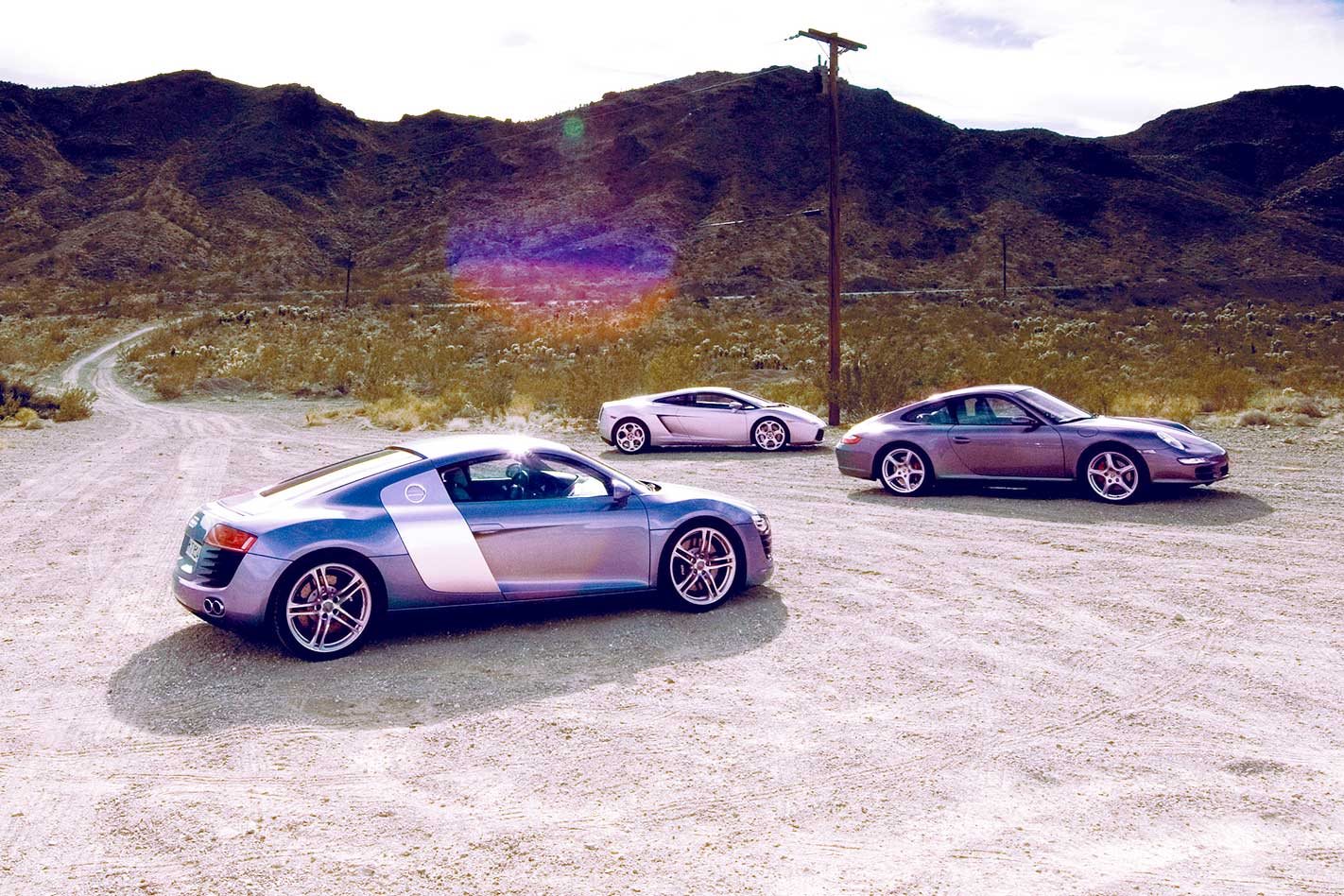It’s taken a while but we finally find a corner. Not a junction, not a kink, not a whisper of a bend with one of those conservative American speed limit signs but a proper European corner, the sort that needs a big armful of lock and an even bigger slug of right foot to negotiate satisfactorily.
This feature was originally published in MOTOR’s April 2007 issue
The bitumen is coarse, the type that shreds tyres in a matter of minutes, while the sand blowing down from the Black Mountains across the Colorado dries your skin like a day sunbaking on the equator.

Clever tapering can’t disguise the long front overhang, but the fact is just 44 percent of the R8’s mass is over the front end. So you twist the wheel and things happen. Try it again with more power and the fat Pirellis hang on then finally slip wide, perfectly synced with righ foot pressure.
And again, but this time with the subtlety of those ‘1-800 whores-to-your-door’ flyers. We’re moving, fast, the very top of second gear, too fast for the front tyres if we keep this speed up. A three-second press of the ESP button has cut out the two-stage stability program (one press allows some slip but will still catch you) and I’m on the outside of the left-hand corner, the apex is approaching, I point the nose to the left and jump off the throttle.
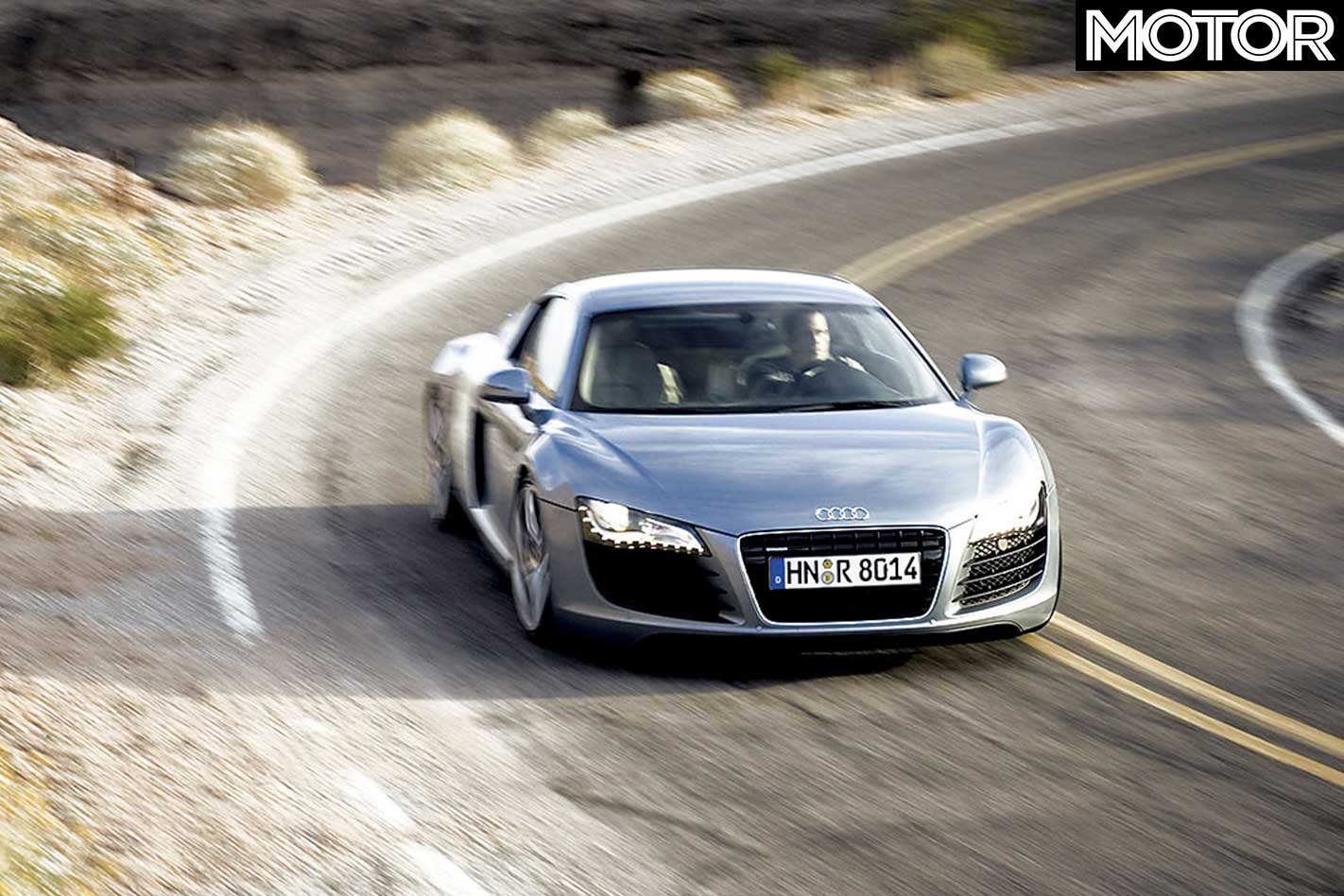
Briskly, but without any hint of impending doom, your twin-cheek yaw-sensor – yer arse to the layman – senses the back tyres have joined the party. There’s not an enormous surfeit of power in this V8 version – the R8 is down 74kW on the Lamborghini Gallardo SE until the 370kW V10 arrives – so it’ll take just about everything your right foot’s got. And there’s just enough juice going up front – between 10 and 35 percent – that it flatters you. And there it is, the R8 broadside, and it’s as happy about it as the bloke behind the wheel.
Time for a reality check. The fact that you can crank the R8 onto the lockstops does not automatically grant it a scholarship to the supercar big league. But it sure does make a refreshing change to be piloting something with four rings on the front that’s so aggressive. The R8 should at least be counted among the big hitters.
To be honest, though, this car could be front-wheel drive and diesel-powered and I’d still want one. It looks sensational, crazy wide, disgustingly low and so Towards 2000 with its flashy LED lights that it almost crossed from Pacific to Mountain Time all on its own.
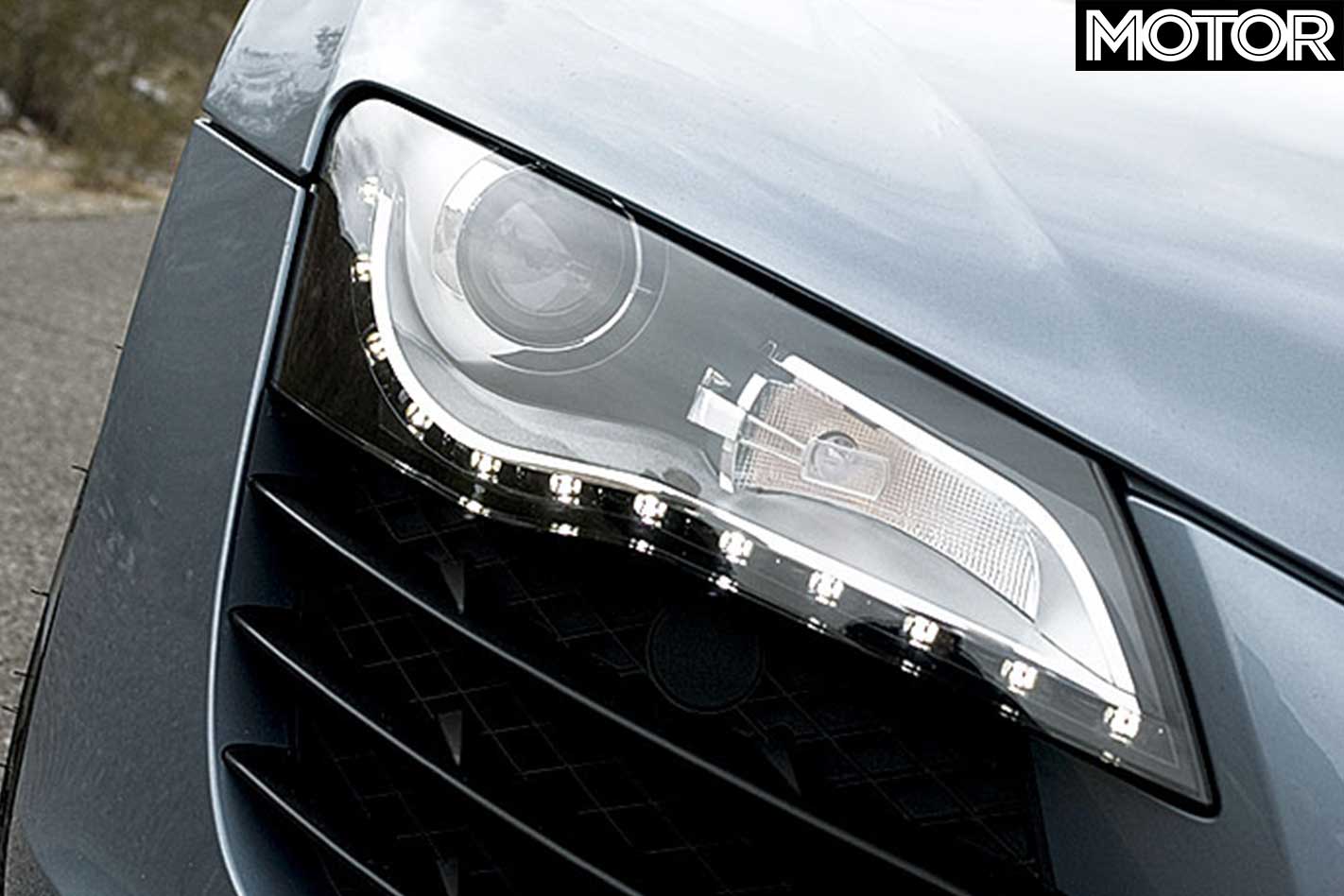
Edgy without the origami creases of the Gallardo, curvy without losing the tautness that characterises muscular designs. Ferrari’s F430 appears fussy in comparison, the Gallardo dated and the Porsche 911 Carrera S is left looking like some sort of frumpy retro joke.
Not everyone would agree of course. Meet Vernon and Bill. Vernon is the owner of this immaculate seal grey 997 Carrera S. Vernon’s high on the Audi hit-list: right age, good job and the keys to a 911 in his pocket.
Sure, the four-wheel-drive Carrera 4S sounds like the more obvious candidate for comparison on paper, but Vernon’s rear-drive Carrera S still has monumental levels of grip, is cheaper and remains the car Audi will have to tempt the majority of guys like Vernon out of.
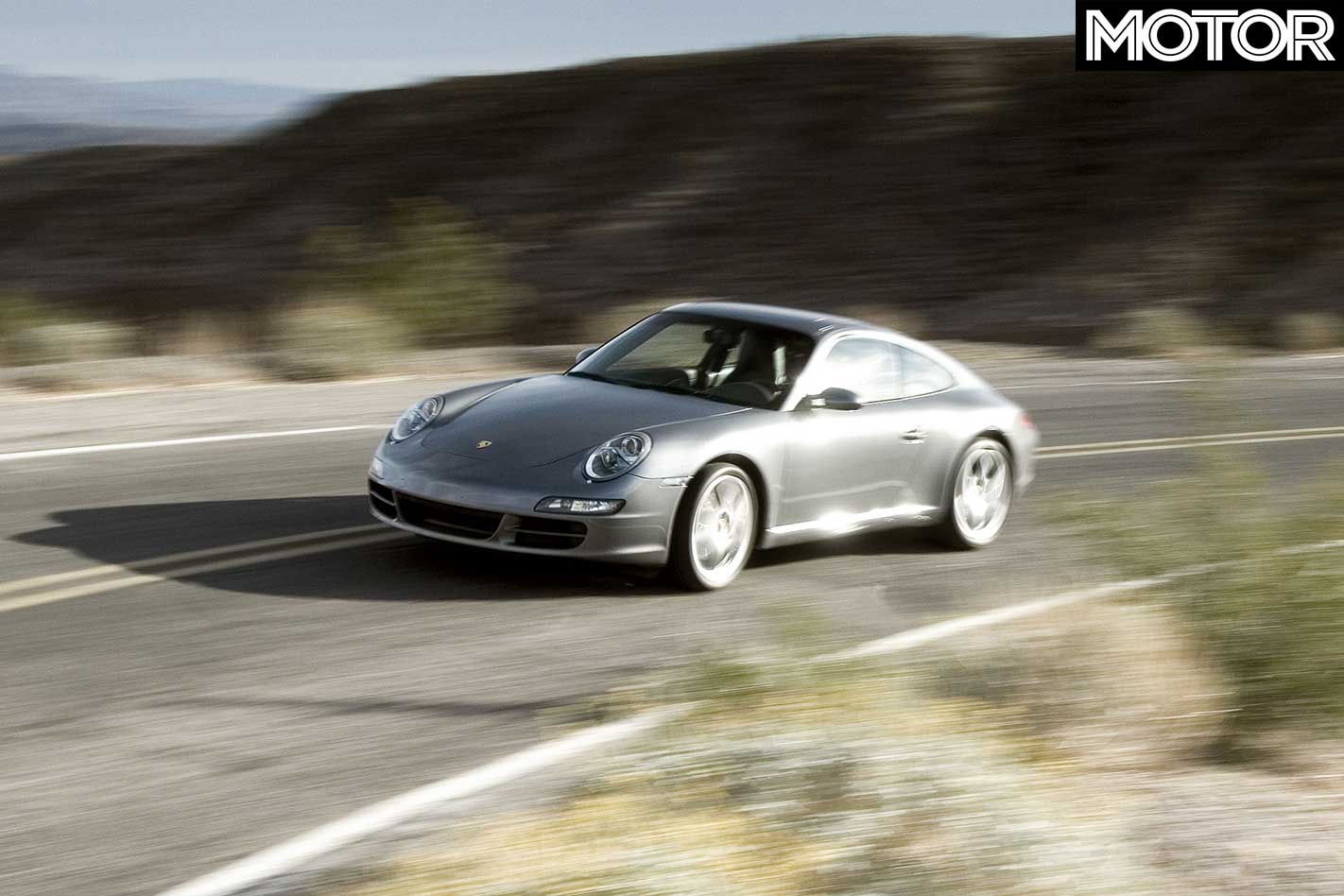
Sure, there are other cars like the Aston Martin V8 Vantage and Mercedes SL, but it’s the 911 that’s the benchmark sub-$250,000 sports car, and provides the real litmus test.
Stepping up a division, for those wanting the R8’s combination of state-of-the-art construction, hi-tech engine behind the seats and genuine supercar performance, you need to spend genuine supercar money on something like Bill’s Gallardo. And even he can’t believe how Audi can make the R8 so affordable.
If we told you it cost a Gallardo-rivalling $400,000 you probably wouldn’t flinch. But get this: it’s expected to cost between $250,000 to $300,000, and that parachutes the R8 deep into the fat-end of 911 territory.
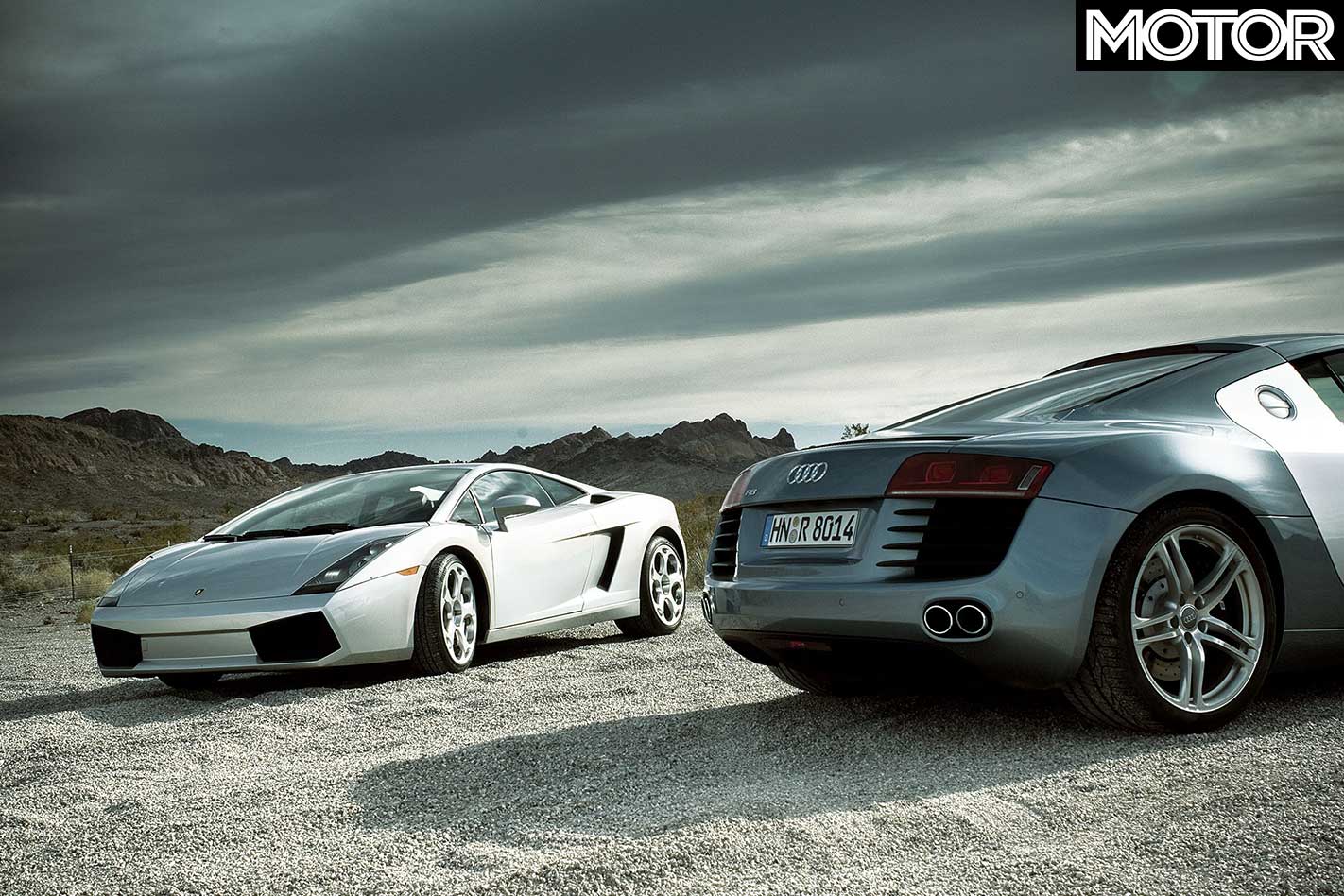
Drop into the R8’s cabin and there’s an odd mix of approval and disappointment. Approval of the shaped door grab handle, the bright white instrument graphics and fabulous materials that fire any notions of this being a cut-price supercar out of the window, but disappointment over the ‘borrowed’ components from lesser Audis. It dims the experience, but only slightly.
The aluminium spaceframe’s long wheelbase (90mm bigger than the similarly-constructed Gallardo’s) offers plenty of room, but the biggest surprise is the visibility. I’ve never driven a supercar like it.
The relatively short, upright windscreen and low scuttle, and the absence of the Lambo’s thick A-pillars means placing the car is easy. Thanks to dry-sumping, the V8 also sits low, aiding rear vision and lowering the R8’s centre of gravity.
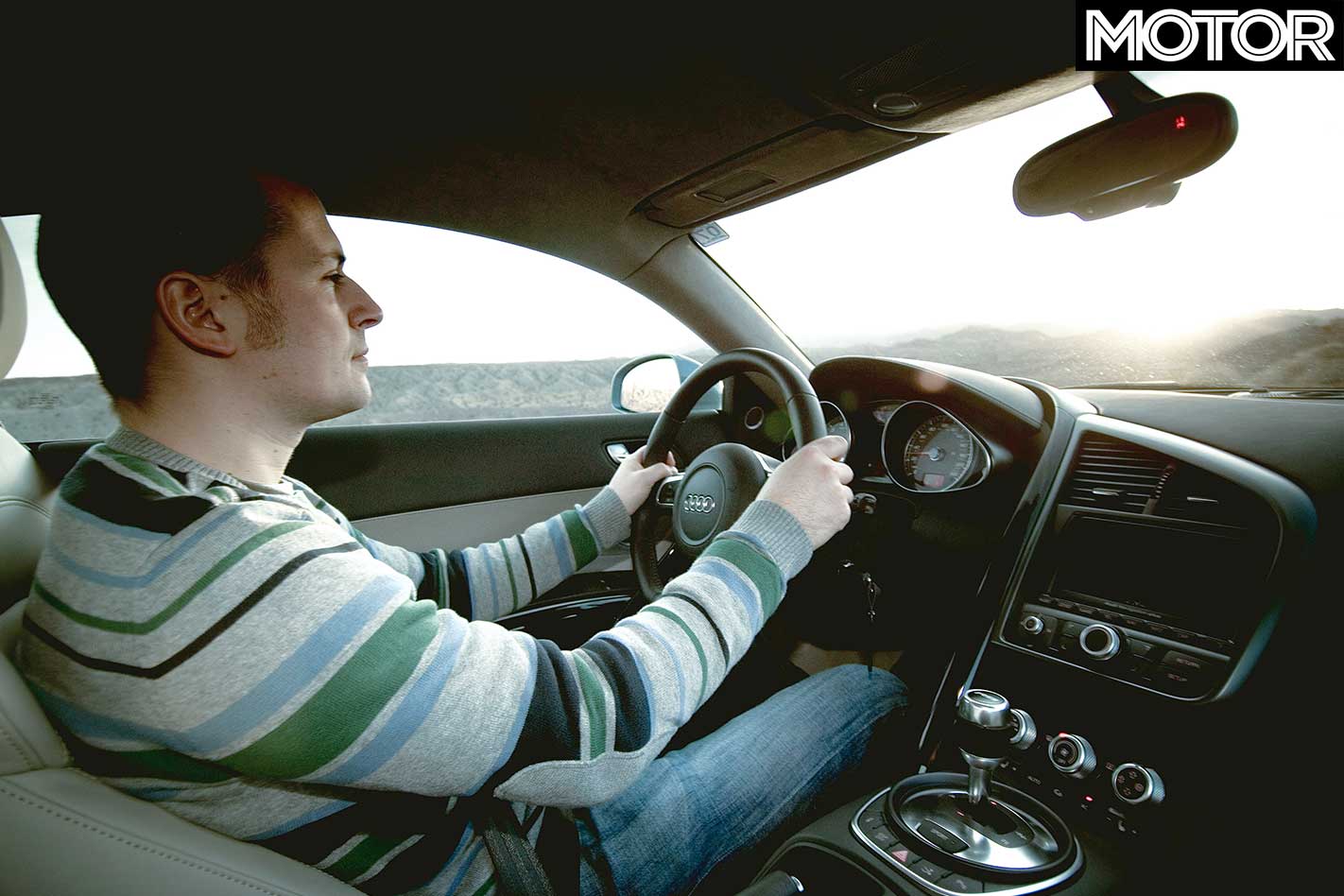
In this company, the Carrera’s interior feels a bit humdrum, but the car still feels right where it really matters: on the road. The steering is quicker, more mechanical in its immediacy of response and feels more communicative than either the R8 or Gallardo set-ups.
Stroking the 997 through a series of left-rights is simply a more positive experience. The R8’s steering is slightly more leisurely and, though linear and accurate, not quite as chatty. And while Lamborghini’s recent changes to the Gallardo have sharpened its steering, the Porsche remains nicer to point and shoot.
Playing with the right pedal results in more aural stimulation in the Porsche; at least compared with the curiously quiet Audi. Blip the R8’s throttle and the response is deep, rumbly. Proper V8 stuff. But unless the windows are down or you’re fanging the nuts off the thing, all you’ll ever hear inside is a fairly anodyne whirring. Rev it right out to 8250rpm and it wakes up but never as much as you’d like. Even the RS4 out-shouts it.
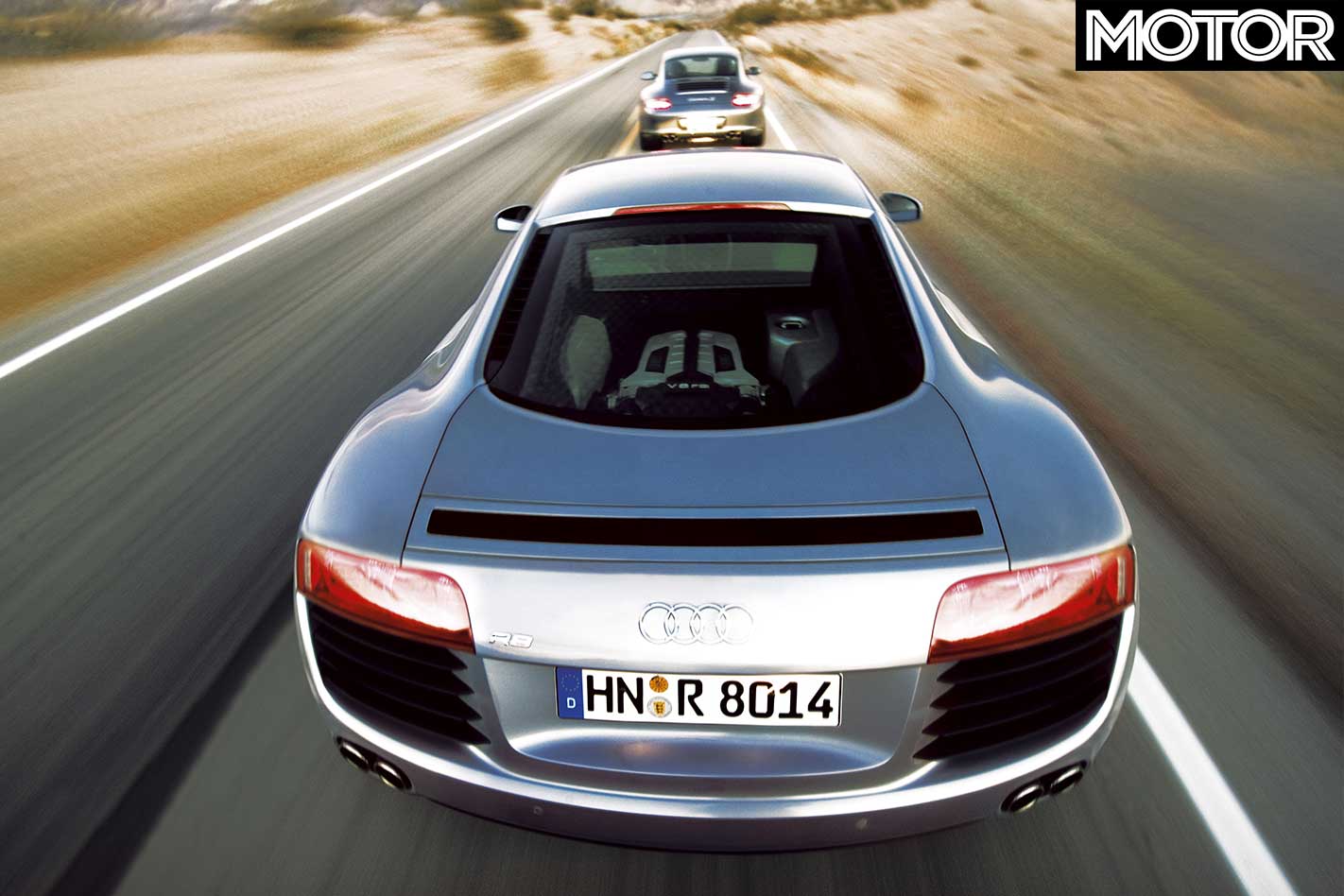
But both are drowned out by the Gallardo. Moving from one to the other is like listening to Malcolm Young in the Velvet Undergound then swapping CDs for the full-on AC/DC experience. It’s loud, menacing and doesn’t care the least bit that it’s probably frightening the hell out of the white-haired Camry drivers who are heading to the strip to flush away their pensions.
When the lights on Vegas Boulevard go green, it’s the Italian that reaches the next intersection first. The on-paper stats – Lambo 3.9 seconds to 100km/h, R8 in 4.6, the Porsche 4.8 – confirm the disparities in power outputs.
The Porsche with 261kW from its 3.8 six weighs 1420kg, compared to 1565kg for the 309kW Audi, so the two are fairly evenly matched. But with 383kW to its name and just 1430kg to account for, it’s no surprise that the Gallardo is the keener to get away.
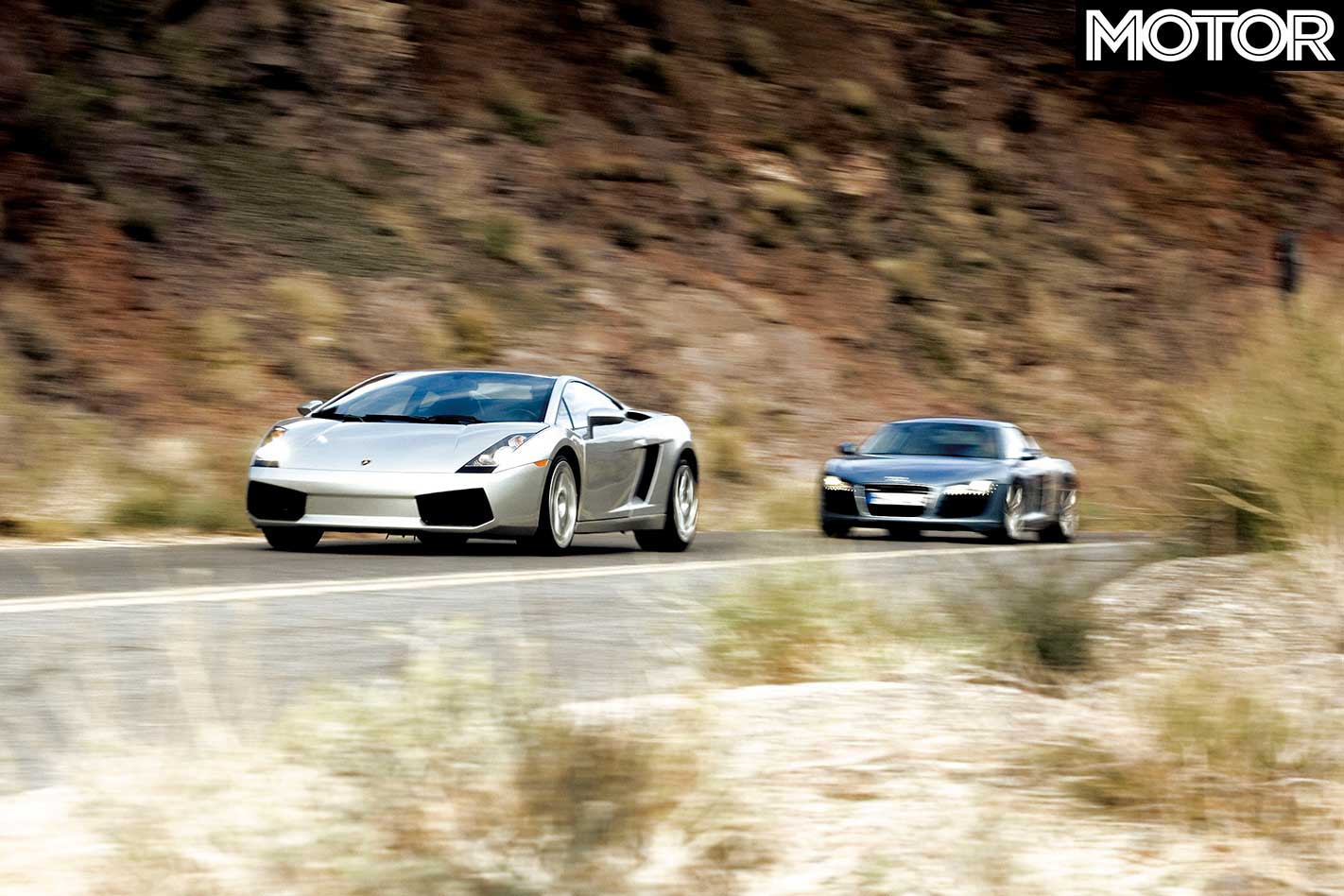
The R8 feels fractionally fleeter than the 911, but not blisteringly fast; and the Lambo, while kicking harder by about the same margin, doesn’t pull away as quickly as you might think. At the top-end, the 301km/h Audi trumps the 293km/h Porsche, while the 315km/h Italian has the legs of both the Germans.
All three cars can be ordered with carbon-ceramic brakes, but when it comes to R8 options boxes I’d leave that one unmarked. The standard steel set-ups are so good there seems little point. Same goes for the sequential R-Tronic gearbox. A tweaked version of the Lamborghini’s e-gear transmission, it’s neither Ferrari F1-quick nor DSG-smooth, and is prone to judder when the plates get hot.
If you must tick something then go for Magnetic Ride supension (MSR) – standard on Australian R8s. Every R8 has double wishbones, but here you get special dampers that electronically adjust to road conditions and driving style, similar to those found on top-end HSVs.
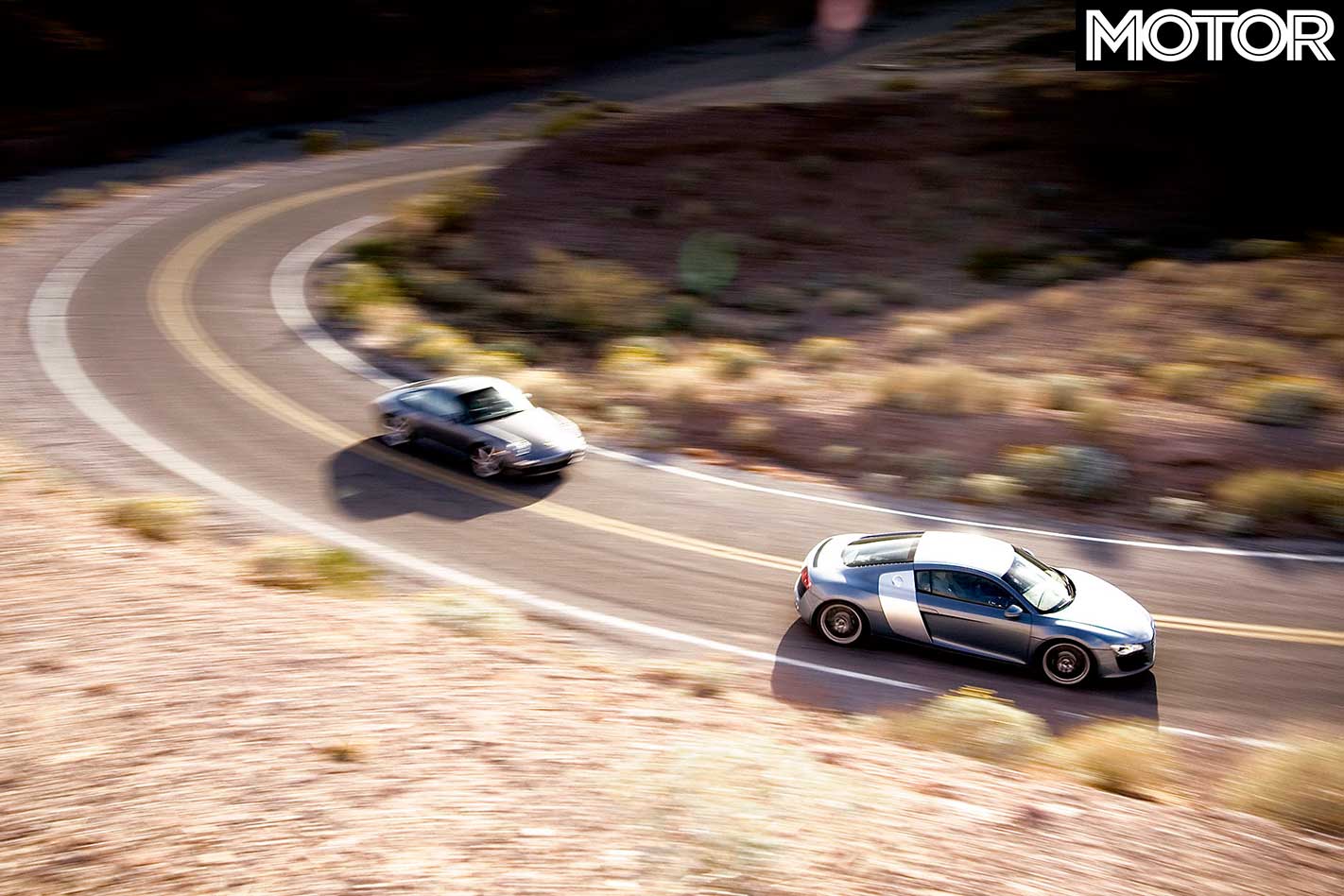
It makes the R8 the most comfortable supercar on sale, at least in normal mode. In fact, it rides better than most of Audi’s sedans, even on the optional 19-inch rims the Oz-spec cars will receive as standard.
It boils down to this: the R8 is a car that – to many people – isn’t that much less exciting to drive than a full-blown $400k exotic and is at least as aesthetically pleasing. It should also be painless to own and costs just two-thirds as much as the cars it apes.
Cars like Bill’s Gallardo will still sell on the strength of their names, their greater performance and more focused character, but the R8 makes it hard – though not impossible – to justify that extra $100k on the price tag.
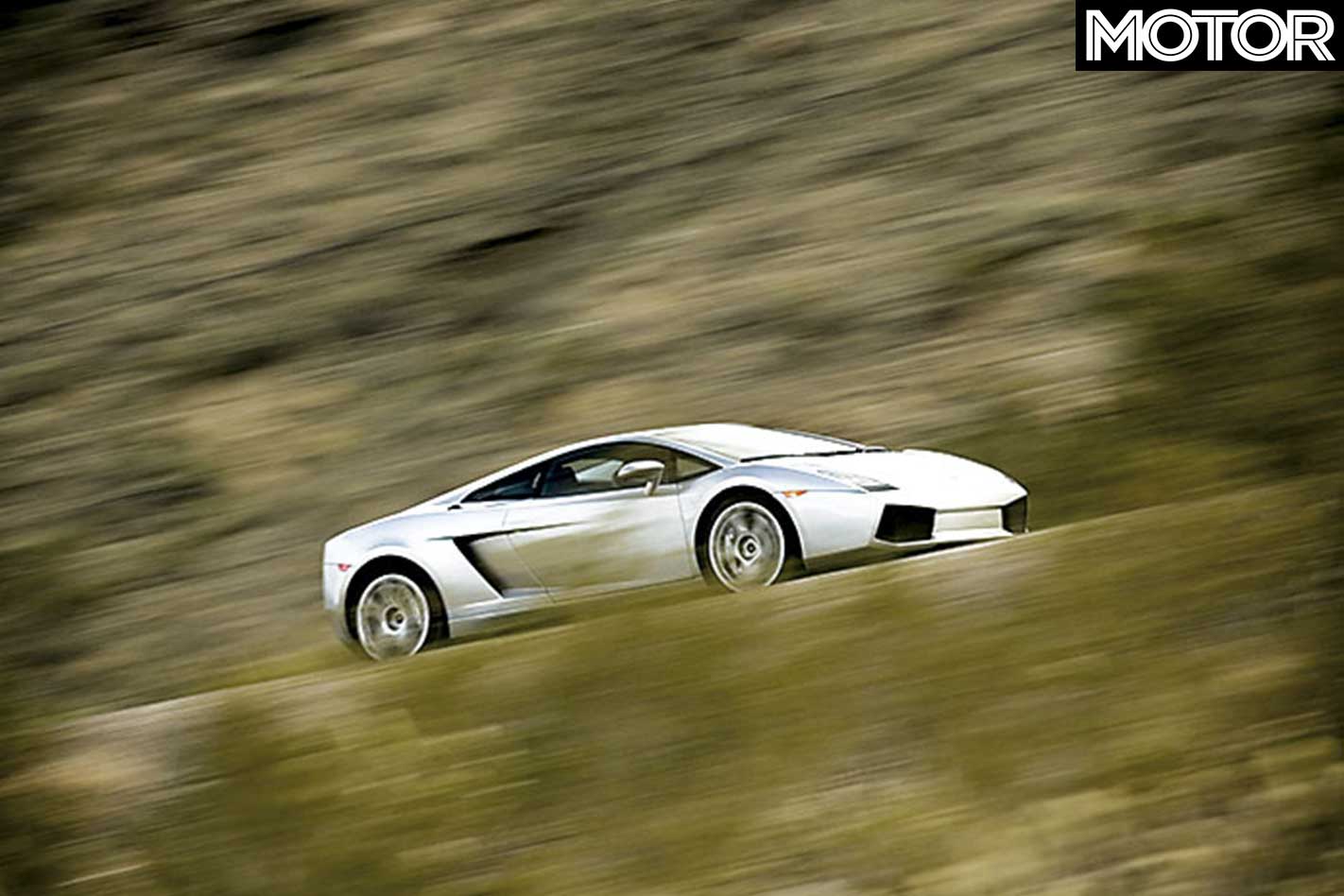
But, with that face, those legs and that price, the R8 is going to have Audi scrambling to increase production from the current 15 cars per day rolling out the factory. It doesn’t stop us lusting after the 911, though.
More than ever in the face of something as stunning as the Audi, the Porsche is a car that can only be appreciated from behind the wheel. Yet, it’s hardly exclusive and offers little sense of occasion. Vernon liked the R8 but isn’t ready to jump ship yet. There’s just something missing, a kind of Lexusification of the supercar concept that leaves him happy with his lighter, pointier, noisier 911.
Audi set out to build a more rounded supercar and some of the sharpness was always going to be lost in the trade off. But not enough to spoil a great car. And Vernom aside, there’ll be plenty who will abandon their 911s for one. Expect the floodgates to open very soon.
Fast Facts

| u00a0 | Porsche 911 Carrera S | Audi R8 | Lamborghini Gallardo |
| Body | 2-door, 2+2-seat coupe | 2-door, 2-seat coupe | |
| Drive | rear-wheel | all-wheel | |
| Engine | 3824cc flat-6, DOHC, 24v | 4163cc V8, DOHC, 32v | 4961cc V10, DOHC, 40v |
| Bore x Stroke | 99.0mm x 82.8mm | 84.5mm u00d7 92.8mm | 82.5mm x 92.8mm |
| Power | 261kW @ 6600rpm | 309kW @ 7800rpm | 383kW @ 8000rpm |
| Torque | 400Nm @ 4600rpm | 430Nm @ 4500-6000rpm | 510Nm @ 4500rpm |
| Power/Weight | 184kW/tonne | 198kW/tonne | 268kW/tonne |
| Transmission | 6-speed manual | ||
| Weight | 1420kg | 1560kg | 1430kg |
| 0-100km/h | 4.8sec (claimed) | 4.6sec (claimed) | 3.9sec (claimed) |
| Top speed | 293km/h (claimed) | 301km/h (claimed) | 315km/h (claimed) |
| Suspension | struts, coil springs, adaptive dampers, anti-roll bar (f), multi-links, coil springs, adaptive dampers, anti-roll bar (r) | double A-arms, coil springs, two-stage magnetic dampers, anti-roll bars (f/r) | double A-arms, coil springs, anti-roll bars, adaptive dampers (f/r) |
| Brakes | 330mm cross-drilled and ventilated discs, four-piston monobloc calipers (f & r), ABS, ESP | 380mm composite discs, eight-piston calipers (f); 356mm composite discs, four-piston calipers (r); ABS, ESP, ceramic discs optional | 365mm vented/cross-drilled discs, eight-piston calipers (f); 335mm vented cross-drileld discs, four-piston calipers (r), ABS |
| Wheels | 19 x 8.0-inch (f), 19 x 11.0-inch (r) | 19 x 8.5-inch (f), 19 x 11.0-inch (r) | |
| Tyre Sizes | 235/35ZR19 (f), 295/30ZR19 (r) | ||
| Price | $224,400 | $270,000 (est.) | $399,346 |
Vegas gamble
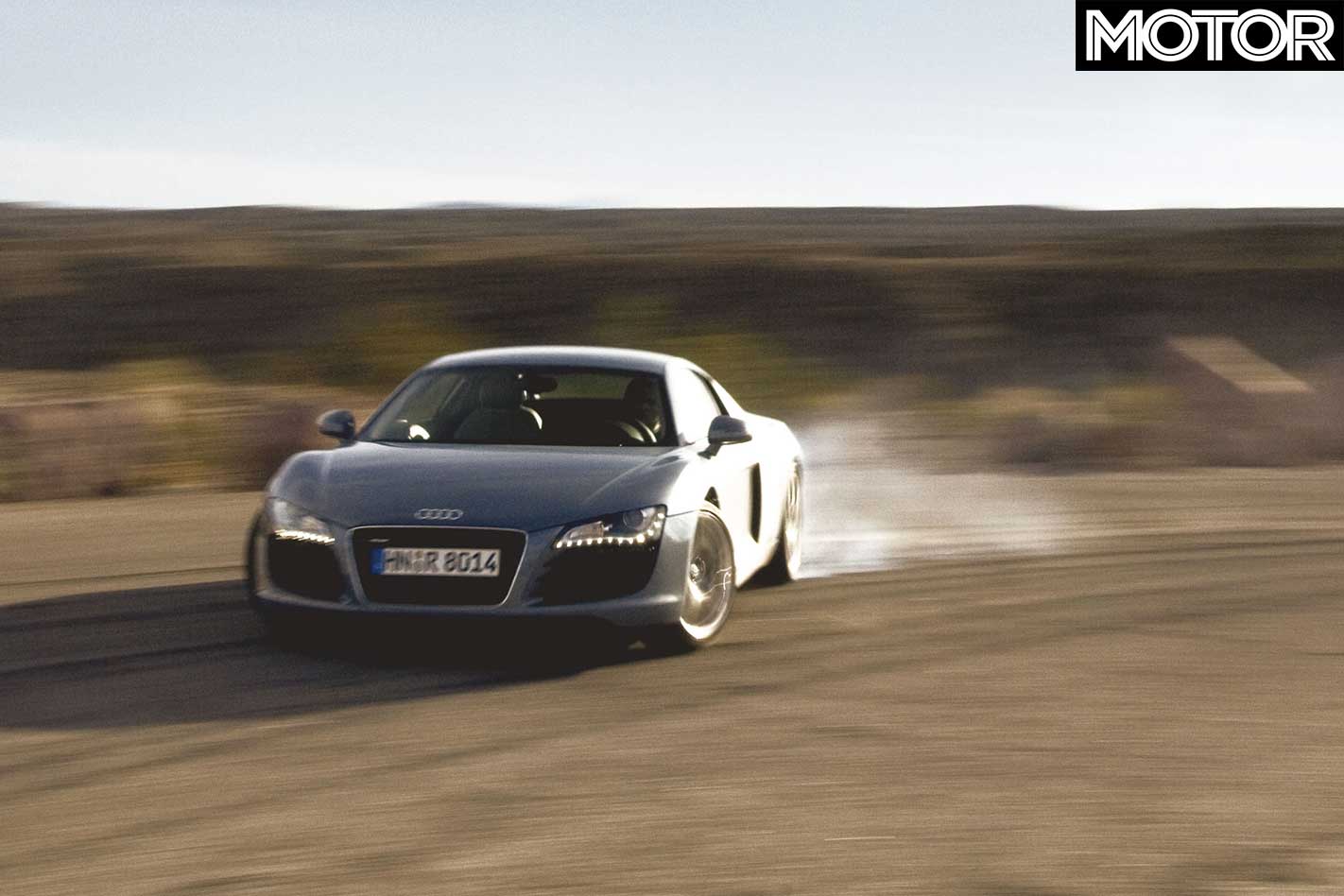
Beautiful place, Nevada, but wouldn’t have been our choice of venue to launch a supercar. Mostly straight roads and over-zealous coppers meant the only twisty stuff was in heavily patrolled national parks with 72km/h limits!
By the time the Oz contingent arrived, Audi had been banned from two of five routes skirting Vegas. After we’d been through the Valley of Fire, the Germans were banned from that, too. Shame, because the R8 deserved better.
It’s an extremely liveable supercar – one you’d be happy doing 25,000km a year in. It’s roomy, comfy, rides well on MRC’s normal setting (standard on Oz R8s), and is rock solid at 280 clicks. Just don’t tell the Vegas filth…
Diversity rules
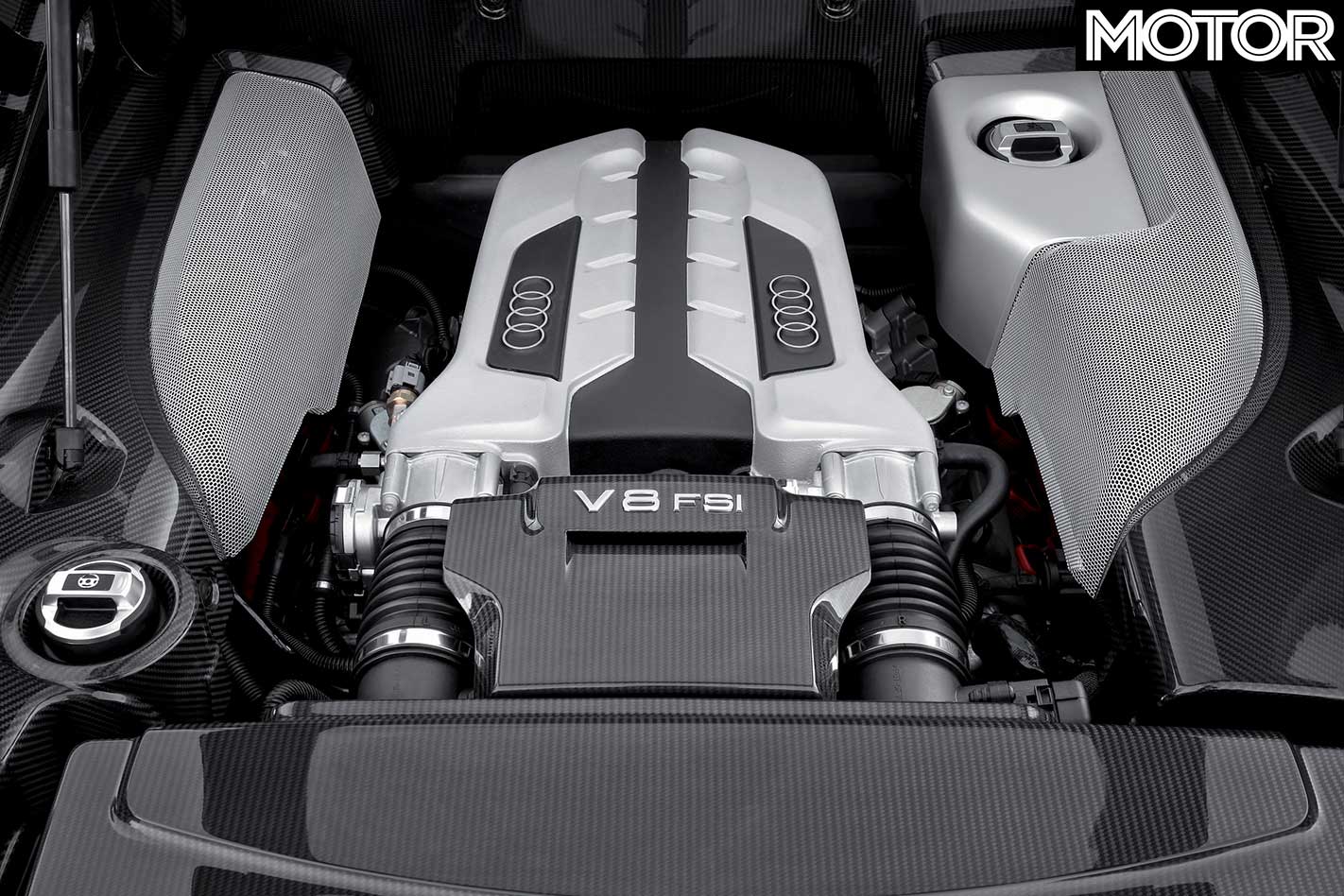
Porsche flat-six was heavily revamped for 2004’s 997-series 911, stretched to 3824cc for the S, while Lamborghini’s sublime 4961cc V10 was brand new in 2003. Audi’s 4163cc V8 started life in the RS4 sedan in 2005 before migrating to the R8, producing identical power and torque (though at slightly different revs). Most work went into its sound.

